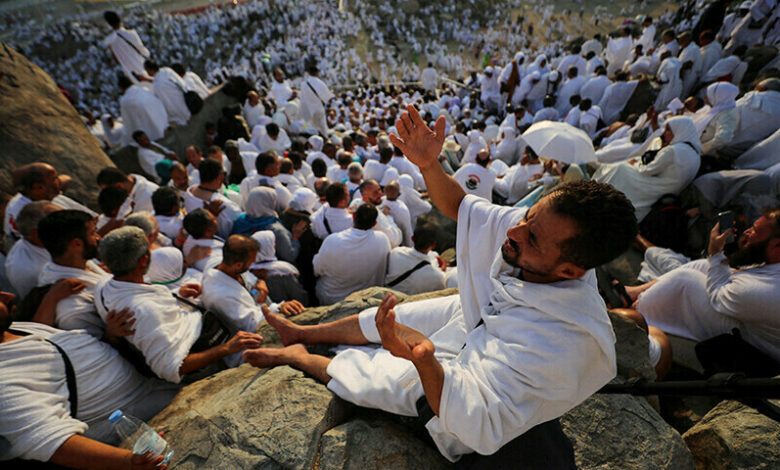Muslims from all over the world pray on Mount Arafat in Haj climax – World


More than 1.5 million Muslims braved extreme heat to reach Mount Arafat on Saturday for the high point of the annual Haj pilgrimage, praying for hours, especially for Palestinians in conflict-ridden Gaza.
Clad in white, worshippers began arriving at dawn for the most gruelling day of the annual rites, ascending the rocky, 70-metre hill where Prophet Muhammad (Peace Be Upon Him) gave his last sermon.
“This is the most important day,” said 46-year-old Egyptian Mohammed Asser, who came prepared with a list of prayers. “I pray also for the Palestinians. May God help them.”
This year’s Haj is unfolding in the shadow of the fighting in Gaza between Israel and Hamas, which was triggered by the latter’s unprecedented attack on southern Israel on October 7.
The assault resulted in the deaths of 1,194 people, mostly civilians, according to an AFP tally based on Israeli official figures.
Israel’s retaliatory military offensive and bombardment in the Gaza Strip has killed at least 37,266 people, also mostly civilians, according to the territory’s health ministry.
Saudi Arabia’s minister in charge of religious pilgrimages, Tawfiq al-Rabiah, warned last week that “no political activity” would be tolerated during Haj.
But that did not stop at least one pilgrim from chanting in support of the Palestinians who have endured more than eight months of incessant bombardment.
“Pray for our brothers in Palestine, in Gaza … may God give victory to the Muslims,” he shouted.
In a message to Haj pilgrims on Saturday, Iranian supreme leader Ayatollah Ali Khamenei said“ “The ironclad resistance of Palestine and the patient, oppressed people of Gaza … must be fully supported in every way.”
Some 2,000 Palestinians are performing the Haj at the special invitation of Saudi King Salman, official media said.
Haj, one of the world’s biggest religious gatherings, is increasingly affected by climate change, according to a Saudi study published last month that said regional temperatures were rising 0.4 degree Celsius each decade.
The rituals, which take at least five days to complete and are mostly outdoors, are “not easy because it is very hot”, said Abraman Hawa, 26, from Ghana.
“We have sun … but it is not as hot. But I will pray to Allah at Arafat, because I need his support,” she added.
The temperature was expected to hit 43°C today, creating challenges for pilgrims who arrived at Mount Arafat after spending the night in a giant tented city in Mina, a valley outside Makkah.
Saudi authorities have urged pilgrims to drink plenty of water and protect themselves from the sun. Since men are prohibited from wearing hats, many carry umbrellas.
Mustafa, an Algerian pilgrim who gave only his first name, clung to his umbrella which was handed out by Haj organisers, saying, “It’s what saves you here”.
Another man, an Egyptian who preferred to remain anonymous, said he was drinking “a lot of juice and water” and had twice stopped to rest on the roadside.
More than 10,000 heat-related illnesses were recorded last year, 10 per cent of them heat stroke, a Saudi official told AFP this week.
Ahmad Karim Abdelsalam, a 33-year-old pilgrim from India, admitted that he found the prospect of passing hours on Mount Arafat “a little scary”.
But with the help of an umbrella and water sprays, “God willing, everything will go well”, he said.
Haj is one of the five pillars of Islam and all Muslims with the means must perform it at least once. Yet visas, doled out to individual countries on a quota system, can be difficult to obtain.
“It’s a chance that only comes once in a lifetime, I couldn’t not come,” said Abdulrahman Siyam, a 55-year-old Iraqi pilgrim who was performing the rituals on a prosthetic leg.
After Mount Arafat, the pilgrims will head to Muzdalifah, where they will collect pebbles to carry out the symbolic “stoning of the devil” ritual in Mina on Sunday.
The Haj is an important source of legitimacy for the Al Saud dynasty, whose monarch has the title “Custodian of the Two Holy Mosques”, in Makkah and Madina.
It is also a major financial windfall for the conservative country, which is trying to develop religious tourism as part of a drive to reduce its dependence on crude oil.
The kingdom received more than 1.8 million pilgrims last year for Haj, around 90pc of whom came from abroad.
It also welcomed 13.5m Muslims who came to perform Umrah and aims to reach 30m pilgrims in total by 2030.
Source link